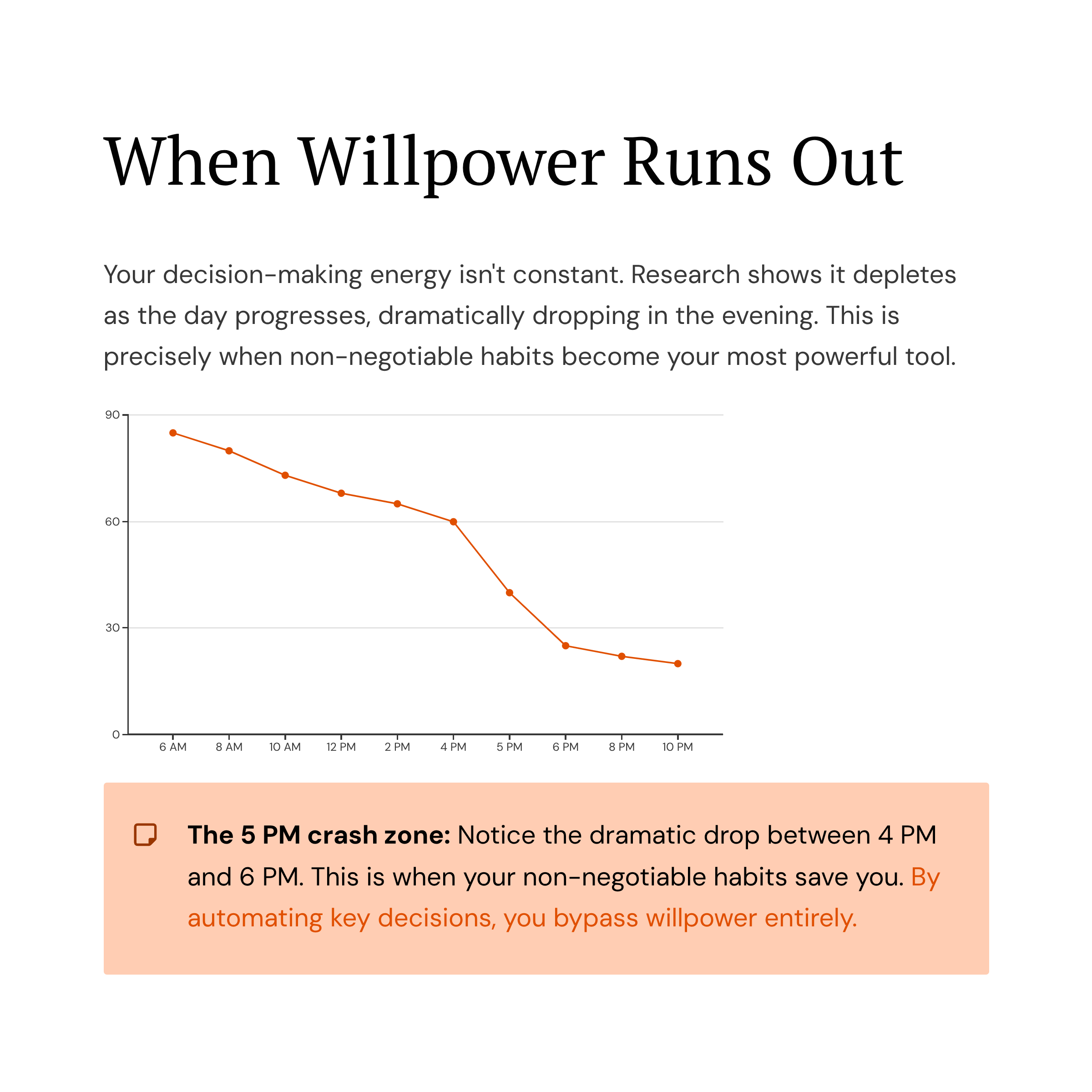Read time: 13 minutes
Quick Summary: Your couch feels like comfort after a long day, but it’s quietly working against you. Every time you choose it over movement, you’re reinforcing neural pathways that make the next choice harder. This post reveals why motivation doesn’t work and how your couch exploits decision fatigue, and the simple systems that make movement automatic, even when you don’t feel like it.

Contents:
- Why Your Couch Knows Exactly When to Strike
- The Motivation Trap (And Why Your Couch Always Wins)
- Why Motivation Doesn't Work (But These 3 Systems Do)
- The Science of Why Motivation Doesn't Work
- Frequently Asked Questions: Why Motivation Doesn't Work & What Does
- 3 Actions You Can Take Today
- Everyday Mastery Steps You Can Take Now
Why motivation doesn’t work: Your couch feels like your ally after a long day. It promises comfort, rest, relief from the grind. But here’s the hard truth: motivation is a trap, and your couch is quietly working against you.
Every time you choose the couch over movement, you’re not just missing a workout, you’re reinforcing a neural pathway that makes the next choice even harder.
Your brain learns: sitting = reward, moving = effort.
The gap widens. The couch wins. This is exactly why motivation doesn’t work, it can’t compete with decades of brain wiring.
And before you know it, you’re stuck in a pattern that feels impossible to break. The sooner you understand why motivation doesn’t work, the sooner you can build systems that actually do.
Why Your Couch Knows Exactly When to Strike
Why can’t I get off the couch after work? Your couch doesn’t work alone, it has a silent partner: decision fatigue. By 5 PM, your prefrontal cortex is exhausted from hundreds of daily decisions, causing your brain to default to the easiest option: sitting. This autopilot response strengthens neural pathways that make choosing the couch easier each time, creating a cycle that feels impossible to break.
By 5 PM, you’ve made hundreds of micro-decisions:
- What to eat
- Which task to tackle
- Whether to respond to that email
- If you really need another coffee
Your prefrontal cortex (the decision-making part of your brain) is exhausted.
Your basal ganglia (the autopilot system) takes over and defaults to the easiest option: your 30-year-old habits.
That’s why you can resist temptation at 10 AM but surrender to the couch at 8 PM.
The couch knows this. It waits for your motivation to dip, then whispers:
“Just today. You’ve earned it. You can start fresh tomorrow.”
The Motivation Trap (And Why Your Couch Always Wins)
Does motivation really not work for exercise? Motivation is an emotion that fluctuates like weather. Relying on it is like only eating when you “feel inspired to cook”you’d starve. By evening, decision fatigue depletes your willpower, causing your brain to default to comfort-seeking behaviours. Systems beat motivation because they create autopilot habits that bypass emotional negotiation entirely.
Here’s what most people do:
- Wake up fired up: “Today’s the day! I’m moving, I’m exercising, I’ve got this!”
- 5 PM hits: Brain negotiates reasons to quit
- Couch wins: “I’m too tired. I had a long day. I’ll do it tomorrow.”
Sound familiar?
The brutal truth? You’ll never feel like doing the hard thing when it matters. This is the core of why motivation doesn’t work as a long-term strategy.
If you’re waiting for motivation to save you, the couch will always be there to catch you. Once you truly grasp why motivation doesn’t work, you can stop fighting yourself and start building automatic systems instead.
Why Motivation Doesn’t Work (But These 3 Systems Do)
Stop chasing the feeling. Start building the identity.
The shift that changes everything: You don’t master yourself through motivation. You master yourself by making certain actions non-negotiable.
Motivation vs. Systems: What Actually Works
| Motivation | Systems |
|---|---|
| Disappears when tired or stressed | Present regardless of emotional state |
| Requires you to “feel like it” | Works on autopilot through identity |
| Lasts 2-4 weeks on average | Becomes automatic after 66 days |
| Fails during decision fatigue | Bypasses decision-making entirely |
Build the system, shift your identity, and the right choice kicks in automatically.

1. Environment Design: Why Motivation Doesn’t Work (But Your Space Does)
Your environment is working 24/7, whether you realise it or not. This is why motivation doesn’t work but environment design does your surroundings make decisions for you before your brain has time to negotiate. Stanford researcher BJ Fogg’s Behaviour Model shows that behaviour happens when motivation, ability, and a prompt converge your environment provides both ability and prompt simultaneously.
What to do:
- Put your trainers by the door (or literally by your feet when you wake)
- Set your workout clothes out the night before
- Remove the TV remote from easy reach
- Add a light timer that makes the living room less inviting at certain times
Understanding why motivation doesn’t work is the first step, then implementing environment design is the second. You’re not adding willpower, you’re removing friction from movement and adding friction to sitting. Learn more about how to use environment design to build habits that actually stick, including the 7 visual triggers that make good habits automatic.
2. Habit Stacking: Link Movement to Things You Already Do
What is habit stacking for fitness? Habit stacking links a new movement habit to an existing daily routine you already do automatically, using the formula: “After [CURRENT HABIT], I will [NEW HABIT].” This concept, popularized by James Clear in his book Atomic Habits, uses your brain’s existing wiring, making new behaviors easier to remember and execute without relying on motivation or willpower.
The couch thrives when you have to “decide” whether to move. Remove the decision.
Habit stacking examples for exercise:
- After morning coffee, I do 10 squats
- I close my laptop, I walk for 5 minutes
- Ive eaten dinner, I stretch for 2 minutes
Your brain already triggers the first habit automatically. The second becomes easier to remember and execute. For a complete guide on how to build 15-minute habit stacks that actually work, including weekly templates and tracking methods, check out our detailed habit stacking system.
3. Identity Shift: Why Motivation Doesn’t Work (But Identity Does)
Stop saying: “I want to exercise more.”
Start saying: “I’m someone who moves.”
Even 2 minutes counts. The couch can’t argue with identity. This is precisely why motivation doesn’t work because it asks “do I feel like it?” while identity simply states “this is who I am.”
When your brain says “I don’t feel like it,” your identity responds: “Doesn’t matter. This is what I do.”
That’s the non-negotiable method in action, a system where you cut off brain negotiation before it starts, making certain actions automatic regardless of how you feel.

The Science of Why Motivation Doesn’t Work
Research backs this up: motivation is an emotion-dependent state that requires you to feel like taking action. When decision fatigue hits, typically around 5 PM -your prefrontal cortex stops having the energy to override 30+ years of established patterns.
According to behavioural science, discipline isn’t about willpower, it’s about creating automated systems that work regardless of your emotional state. This is why motivation doesn’t work for long-term change: emotions are unreliable, but systems are consistent.
Research from University College London found that it takes an average of 66 days for a new behaviour to become automatic—not the often-cited 21 days. The study by Phillippa Lally and colleagues, published in the European Journal of Social Psychology in 2009, showed that simple habits can automate faster (18-21 days), while complex habits like exercise can take 200+ days. The key isn’t intensity—it’s consistency.
This is especially important if you’re starting to exercise when overweight or returning after a long break. Small, consistent actions create stronger neural pathways than sporadic intense efforts that burn you out.
What to Do When Your Brain Negotiates?
How do I stop negotiating with myself about exercise? Use the 5-4-3-2-1 countdown method: the moment you have an instinct to move, count down 5-4-3-2-1, then physically move before your brain builds a case for why you shouldn’t. Mel Robbins, who popularized this technique in her book The 5 Second Rule, explains that you have just five seconds before your brain kills the impulse to act. This interrupts the negotiation pattern and creates immediate action through a behavioral identity shift. Understanding why motivation doesn’t work helps you stop relying on feelings and start using action-based systems instead.
Here’s what goes through my mind on the hard days:
Brain: “I’m tired. I can’t work out today.”
Me: “Yes, you can. That’s what you do.”
Brain: “I had a long day. I deserve to skip today.”
Me: “We don’t just stop when it gets hard. Life is hard. Move it.”
The thoughts are regular visitors:
- “I’m tired”
- “I had a long day”
- “I can skip today”
Acknowledge them, let them pass, and move immediately.
If I literally can’t be arsed to walk, I stand up the second the thought arrives. I do not allow my brain to build a case for why I shouldn’t.
Because once it starts negotiating, it’s game over. The NHS Better Health programme emphasizes that small environmental changes and immediate action significantly improve health behaviour consistency, especially when you stop waiting for motivation and start building automatic responses.
Why Motivation Doesn’t Work: The Real Enemy Is Friction
Every small barrier between you and movement feeds the couch’s power. Friction reduction is the key to creating non-negotiable routines that work on autopilot:
Common friction points:
- Finding workout clothes
- Choosing what to do
- Feeling low energy
- Deciding if you should move
Remove friction ruthlessly through environment design:
- Lay out clothes the night before
- Choose one simple movement (walk, stretch, squats)
- Start with 2 minutes—anything beyond that is a bonus
- Make movement the path of least resistance
Make things easier, and your brain stops fighting you. Action happens on autopilot
Frequently Asked Questions: Why Motivation Doesn’t Work & What Does
Why do I always choose the couch over exercise?
Your brain defaults to the couch because of decision fatigue and neural pathway reinforcement. By evening, your prefrontal cortex is exhausted from daily decisions, causing your autopilot system to take over and choose the easiest option. Each time you choose the couch, you strengthen these neural pathways, making future choices even harder.
How can I make myself exercise when tired?
Don’t rely on making yourself “feel like it.” Instead, use the non-negotiable method: remove decision-making by creating environmental cues (trainers by the door), habit stacking (link movement to existing routines), and identity shifts (“I’m someone who moves” vs “I want to exercise”). These systems work when motivation fails.
What is the 5-4-3-2-1 method for movement?
The 5-4-3-2-1 countdown method, popularized by Mel Robbins, interrupts brain negotiation. When you have an instinct to move, count down 5-4-3-2-1, then physically move before your brain builds resistance. This creates immediate action and prevents the internal debate that typically leads to choosing the couch.
Why does motivation work at first but then fail?
Motivation is an emotion-dependent state that fluctuates throughout the day and depletes over time. Initial motivation lasts 2-4 weeks on average, but once decision fatigue sets in (typically by 5 PM) and the novelty wears off, your brain defaults to 30+ years of established comfort-seeking patterns. Systems bypass this by creating automatic behaviors that don’t require emotional states.
How long does it take to build automatic exercise habits?
Research from University College London shows it takes an average of 66 days for a behavior to become automatic. In their 2009 study published in the European Journal of Social Psychology, Phillippa Lally and colleagues found that simple habits (like drinking water after waking) can automate in 18-21 days, while more complex habits (like daily exercise) may take 3-4 months or longer. Consistency matters more than intensity—small daily actions create stronger neural pathways than sporadic intense efforts.
The Bottom Line
Your couch will always be there.
The question is: Are you building systems that make choosing movement automatic, or are you fighting a motivation battle you’ll eventually lose?
Now you understand why motivation doesn’t work, and more importantly, what does: environment design, habit stacking, and identity shifts that bypass emotional negotiation entirely.
Stop negotiating with yourself. Stop waiting to feel like it.
Start where you are, start small but start today
Because the couch isn’t your friend, but your future self, the one who moved despite not feeling like it, absolutely is.
Mr Critic Moment

Mr Critic Moment:
“You’ll just quit in a week anyway. Why bother starting?”
That’s the voice that wants you to stay comfortable. It disguises itself as wisdom, but it’s just fear dressed up as logic.
The truth? You don’t need to commit to forever. Just commit to today.
3 Actions You Can Take Today
- Put your trainers somewhere you’ll trip over them tomorrow morning
- Choose ONE habit stack: After [existing habit], I will move for 2 minutes
- When your brain says “not today,” count down 5-4-3-2-1 and move anyway
Everyday Mastery Steps You Can Take Now
- Notice when your couch whispers the loudest, that’s your decision fatigue window
- Design one small environmental cue tonight (trainers, water bottle, journal)
- Practice the restart: if you skip today, tomorrow you go again with no punishment, no drama

Journaling Prompt:
What does your couch tell you when you’re tired? What would happen if you cut that negotiation off tomorrow and just moved anyway?
Write it down. Make it real.
Ready to build systems that work when motivation doesn’t?
This is your permission slip to start messy.
We don’t chase perfect here, we practise progress – That is Everyday Mastery
Download our free Habit Stacker eBook with practical templates and weekly checklists.
Or join the Everyday Mastery Newsletter for weekly wisdom on building unshakeable habits.
Found this helpful? You can buy me a coffee to support more writing like this. Every cup helps me keep creating resources that help you build the life you actually want.
Kel is the writer behind Everyday Mastery, where she shares the real, messy, and meaningful process of building habits, resilience, and self-belief from the ground up. Her writing blends ancient philosophy with modern science, always focused on small, practical steps that lead to lasting change.
Kel is the writer behind Everyday Mastery, where she shares the real, messy, and meaningful process of building habits, resilience, and self-belief from the ground up. Her writing blends ancient philosophy with modern science, always focused on small, practical steps that lead to lasting





